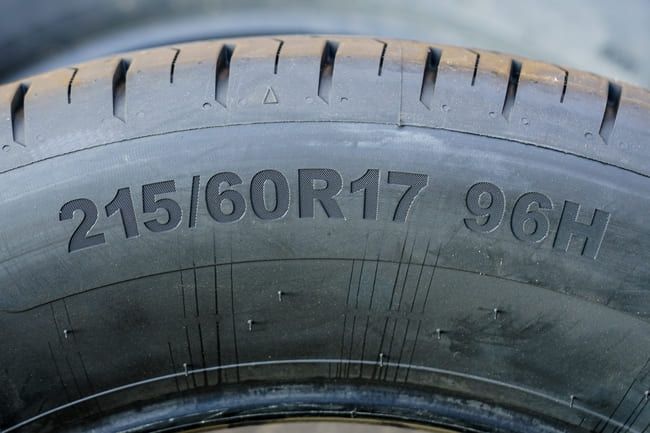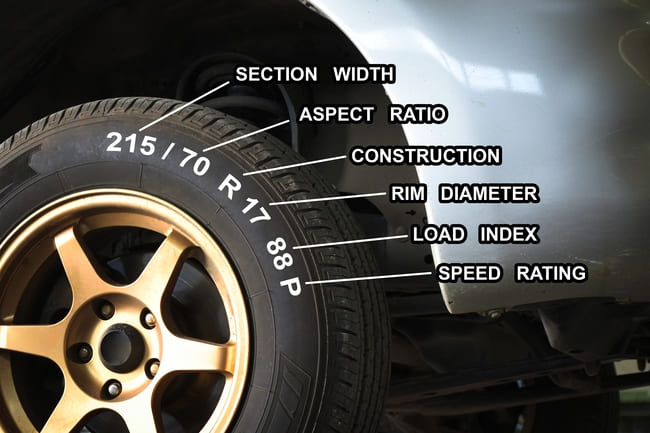Table of Contents
Car tyre speed rating: table, meaning, and differences
Understanding the car tyre speed rating is essential for safe and efficient driving. This index indicates the maximum speed a tyre can handle while maintaining performance. In this guide, we'll explore the meaning of speed ratings, explain their differences, and provide a handy table to help you choose the right tyres for your car.
What is the tyre speed rating?
The speed ratings on tyres indicate the top speed the car tyres can travel at while supporting their maximum load. It is important to note that this speed may only be safely reached in optimum conditions. It’s represented by a letter, such as “H” or “V,” found on the tyre sidewall.

This rating helps drivers match tyres to their vehicle's performance capabilities, ensuring safety and handling at high speeds. It is determined through rigorous testing and is vital for maintaining stability, braking efficiency, and overall performance. Choosing the correct one ensures effective handling and reduces the risk of blowouts.
Does the speed rating matter for tyres?
Yes, the speed rating matters because it ensures tyres can safely manage your vehicle's performance demands. A higher rating isn’t always better—it depends on your driving habits and vehicle specifications.
Sold by AUTODOC Sold by AUTODOC Sold by AUTODOC Sold by AUTODOC Sold by AUTODOC 

















High-speed tyres (e.g., "V" or "Z") are designed for faster speeds and deliver better handling and stopping power, but they often wear out quicker and cost more. If you drive a standard car at regular speeds, a moderate rating (e.g., "T" or "H") should suffice.
Tyre speed rating chart
This speed chart can be referred to when trying to work out the maximum speed each tyre supports. Organised by alphabetical codes like “H” or “V,” it helps drivers select products suited to their vehicle’s performance needs. Use the chart to match speed capabilities for optimal safety and driving efficiency.
|
Speed rating |
Maximum speed (km/h) |
Maximum speed (mph) |
|
N |
140 |
87 |
|
P |
150 |
93 |
|
Q |
160 |
99 |
|
R |
170 |
106 |
|
S |
180 |
112 |
|
T |
190 |
118 |
|
U |
200 |
124 |
|
H |
210 |
130 |
|
V |
240 |
149 |
|
W |
270 |
168 |
|
Y |
300 |
186 |
|
Z |
Over 240 |
Over 149 |
Difference between V and W tyres
V-rated tyres can handle speeds up to 149 mph, while W-rated tyres support speeds up to 168 mph. W tyres are designed for higher performance vehicles, offering better handling at increased speeds. However, they may wear out faster and are often pricier. V-rated products are suitable for sporty but less extreme driving conditions, providing a balance of durability, performance, and cost-effectiveness for everyday use.
Difference between V and H tyres
H-rated tyres support speeds up to 130 mph and are commonly used on sedans, compact SUVs, and family cars. V-rated tyres handle speeds up to 149 mph and are designed for sportier vehicles or high-performance sedans. V tyres offer enhanced handling and grip at higher speeds, while H tyres typically prioritise comfort and durability for everyday driving.

Difference between Y and W tyres
W-rated tyres can handle speeds up to 168 mph, while Y-rated tyres support speeds up to 186 mph. Both are designed for high-performance vehicles, but Y-rated tyres are typically used on supercars and ultra-high-speed sports cars. W-rated products are better suited to high-performance sedans, sports cars, and luxury vehicles that demand excellent handling and stability at lower high-speed thresholds.
How to find the tyre speed rating: where is it?
The tyre speed rating is located on the sidewall, as part of the tyre’s alphanumeric code. Example: tyres 225/50R17 94V. Here’s what it means:
- 225: tyre width in millimetres
- 50: aspect ratio (height to width percentage)
- R17: radial construction, 17-inch wheel diameter
- 94: load index (maximum weight capacity)
- V: speed rating (maximum speed: 240 km/h or 149 mph)
The speed rating is always the last letter in the sequence. Sometimes this information is also recorded in the owner’s manual or on the driver’s door jamb.
How to choose tyres with the right speed index
Start by checking your current tyres, the vehicle’s manual, or the information placard (usually on the driver’s door frame) for the recommended speed rating. For high-performance vehicles, opt for higher ratings like V, W, or Y. DO NOT purchase products with a lower rating than the recommended one to avoid stability and handling issues.
Make sure to match the tyre’s load index with your vehicle’s weight requirements. All 4 tyres should have the same ratings to avoid uneven wear and performance issues. It is generally advised to replace all 4 at the same time.
Sold by AUTODOC Sold by AUTODOC Sold by AUTODOC Sold by AUTODOC Sold by AUTODOC 


















Speed index for winter, summer, and all-season tyres
The speed index for winter, summer, and all-season tyres may vary based on the vehicle and driving conditions. Winter tyres are sometimes given a lower speed index (e.g., T or H) due to their focus on traction in cold, snowy conditions. Summer tyres often have higher ratings (e.g., V, W, or Y) as they are designed for performance at higher temperatures and speeds.
In most cases, all-season tyres typically fall between these extremes, with ratings like H or V, balancing performance in various conditions. Whatever the case, the speed requirements must be met in all seasons – pick tyres with the recommended index or higher. Always follow the vehicle’s manufacturer recommendations for the appropriate specifications.
Top products related to this topic:




































